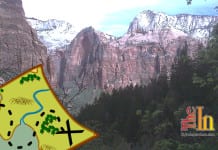
What the mainstream media haven’t told you about the border
I flew to El Paso to see for myself what was going on at the border at the height of the partial government shutdown standoff between Pelosi, Schumer, and President Donald Trump. I wanted to interview those on the ground who really knew, thus bypassing entirely the Republican presses that said we were in a border crisis and the Democrat presses that said we weren’t and that we do not need a wall. El Paso, with a population of over 800,000, and Juarez, Mexico, with a population of over 1,400,000 — one north of the border, the other south — seemed to be an ideal location to ask the experts.
This is what I learned.
Mexican cartels, not the Mexican government, control entry into the United States. They are the de facto government south of the border. Cartels have carved up the important crossing locations, and migrants do not get into the United States without first paying at least $100 per person to the controlling cartel. They enforce their rules.
Agents do not seek out illegal aliens as they once did. Aliens come to them. Most illegal immigrants, perhaps 80 percent of them, are referred to as “Other Than Mexican,” or OTM’s. Mexicans, when caught, are simply returned to Mexico. But the OTM’s have the right to have a judge hear their cases, thus they remain until that happens.
Caravans are a new phenomenon. These are financed, we were told, by billionaire George Soros. His groups organize and instruct perspective migrants in their rights. After crossing Mexico, these people approach the border in small groups of nine to 20 and immediately seek a border patrol vehicle to approach and surrender, “Here I am!” They know that they will be taken to a holding center and cared for. These centers, designed for 80 to 90 migrants, now hold 200 to 250. They are so crowded that there exists virtually no room between migrants.
They know they will be released into the general population after receiving a Notice To Appear before a judge, but they also know not to appear as 90 percent will be sent home as they do not qualify for asylum.
But now they are in the United States. The game changes to “hide and seek” until the United States changes its laws. Why? One officer told us that they were awaiting the expected “paradigm shift.” He did not explain what he meant, but I inferred that there is an expectation that Trump will be removed from power, and their group enormity will force a path to full citizenship. He added, “When this hope of being able to stay is removed, this incentive, the flood will end.”
Agents invited us to visit three unsecured areas within 30 miles of where we were.
The first was Mount Cristo Rey, located between the two cities but a good distance into the U.S. side. It was identified as a place of danger. The sign posted on the well trod 12-foot-wide trail going up the hill to the statue warned, “If you’re going to tour Mt. Cristo Rey please contact police department at (575) 589-6600 or at 1000 McNutt Rd.”
Why would an area within the country and close to Border Patrol headquarters be too dangerous for Americans to visit without first notifying police?
Because it is also a corridor for drug and human trafficking between the two countries, and you might disappear, be raped, or robbed.
A second unsecured areas was a construction site on the U.S. side of the border accessed by an opening in an 18-foot-tall border wall with no visibly mounted cameras, through which construction trucks and workers frequently passed. An almost dry Rio Grande River just south of the construction site had no barrier of any kind to prevent a crossing from either side.
A third site, some 25 miles west of El Paso, was the connecting point between a high fence, perhaps 18 feet, and a four- or five-foot-high fence thereafter. The much shorter fence was designed to stop only automobiles, and Mexico was easily accessed from both sides by climbing over the top or sliding under it. I had one foot in Mexico and another in the United States simultaneously. Picture very large steel X’s every ten feet with three horizontal cross beams connecting them. This fence was said to continue this way for some distance west but replaced with mere barbed wire thereafter.
The fence was marked as having been built in 2008, but it was no barrier to drug or human trafficking or coming across unnoticed at will. We were totally alone for a solid hour before we saw a helicopter flying the line. There was no evidence of technology, and we were but 20 miles from one of the most populated areas on the entire border.
We also learned that the countries from which immigrants come often do not want them back as they were happy to rid themselves of their impoverished or criminal class. Twenty years ago, the border could be controlled by 5,000 agents. Now 35,000 agents are required. Even U.S. troops are needed to assist.
No one argued that this was not a very serious crisis, nor that a border wall was not critical in ending it. Border patrol agents confirmed, “There is no border security outside a wall.”
The viewpoints expressed above are those of the author and do not necessarily reflect those of The Independent.
How to submit an article, guest opinion piece, or letter to the editor to The Independent
Do you have something to say? Want your voice to be heard by thousands of readers? Send The Independent your letter to the editor or guest opinion piece. All submissions will be considered for publication by our editorial staff. If your letter or editorial is accepted, it will run on suindependent.com, and we’ll promote it through all of our social media channels. We may even decide to include it in our monthly print edition. Just follow our simple submission guidelines and make your voice heard:
—Submissions should be between 300 and 1,500 words.
—Submissions must be sent to editor@infowest.com as a .doc, .docx, .txt, or .rtf file.
—The subject line of the email containing your submission should read “Letter to the editor.”
—Attach your name to both the email and the document file (we don’t run anonymous letters).
—If you have a photo or image you’d like us to use and it’s in .jpg format, at least 1200 X 754 pixels large, and your intellectual property (you own the copyright), feel free to attach it as well, though we reserve the right to choose a different image.
—If you are on Twitter and would like a shout-out when your piece or letter is published, include that in your correspondence and we’ll give you a mention at the time of publication.



